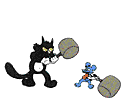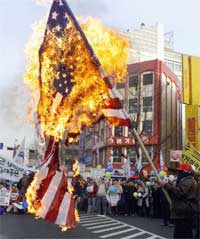Part 2: The Law (as Defined through Court Cases)
 The courts have attempted to make a major distinction when it comes to limiting free speech. They have ruled that restricting the content, viewpoint, or ideas behind speech is never acceptable. However, restricting time, place, and manner of speech is acceptable. For instance, we could pass a law that prevented you from speaking using bullhorns at night since it only restricts the manner of speech. We could not, however, pass a law that prevented you from speaking against the government using a bullhorn as that would target the message or idea of your speech.
The courts have attempted to make a major distinction when it comes to limiting free speech. They have ruled that restricting the content, viewpoint, or ideas behind speech is never acceptable. However, restricting time, place, and manner of speech is acceptable. For instance, we could pass a law that prevented you from speaking using bullhorns at night since it only restricts the manner of speech. We could not, however, pass a law that prevented you from speaking against the government using a bullhorn as that would target the message or idea of your speech.
Within this distinction between restricting the manner but not the message of speech, the courts have upheld laws restricting free speech for the following reasons:
Libel/slander/false advertising
For instance, lying about you in public in order to damage or harm to your reputation. To qualify as libel/slander the speech must not only be false, but also "malicious." False advertising involves lying about, or misrepresenting a product or service.
Inciting harm or probability of harm
For instance, yelling "fire" in a crowded theater (when there is no fire) is likely to cause harm to people. Or, shouting "kill the capitalist" in front of an angry mob of communists. Or, the use of fighting words (saying "fascist pig" in a face-to-face context that is likely to provoke a fight).
National security
This requires that citizens cannot divulge secrets of the government or military when this information is dangerous or harmful to our nation. For instance, reporting the location of a secret military operation going on behind enemy lines.
Obscenity
Obscenity is expression that lacks any social value (pornography, nude dancing) unless it's "art." This can include language or actions, but is most prominently used to restrict pornography, which is generally defined as sexually obscene material.
Of these four, the first three are directly related to claims of "harms" whereas the fourth does not require any harm in order for society to restrict speech. Of course, obscenity is very difficult to define as is "artistic value," but it is interesting to note that the courts do not require the state to show harm in order to restrict speech lacking any social value. Is there a justification for this? If there is a justification for limiting obscenity; what sorts of things can we think of that meet this definition of obscenity? Keep this issue in mind as we will return to the subject of obscenity/pornography in Module 4.
 We might also take issue over the concept of "fighting words." Fighting words as a legal limitation on speech arises out of the case: Chaplinsky v. New Hampshire . The case involved a Jehovah's witness who addressed a police officer as a "God dammed racketeer" and "a damned fascist " This court ruling established the concept of "fighting words" as: extremely hostile personal communication likely to cause immediate physical response, "no words being forbidden except such as have a direct tendency to cause acts of violence by the persons to whom individually the remark is addressed." Thus "fighting words" are not protected free speech. Yet, what specifically constitutes fighting words?
We might also take issue over the concept of "fighting words." Fighting words as a legal limitation on speech arises out of the case: Chaplinsky v. New Hampshire . The case involved a Jehovah's witness who addressed a police officer as a "God dammed racketeer" and "a damned fascist " This court ruling established the concept of "fighting words" as: extremely hostile personal communication likely to cause immediate physical response, "no words being forbidden except such as have a direct tendency to cause acts of violence by the persons to whom individually the remark is addressed." Thus "fighting words" are not protected free speech. Yet, what specifically constitutes fighting words?
Cohen v. California
WEBLINK: Click here to read the Cohen v. California case
This case involved a challenge to the concept of fighting words as established in Chaplinsky. Cohen was convicted of "fighting words" for wearing a jacket with the words "Fuck the draft" inside a Los Angeles county courthouse during the Vietnam war. However, the court overturned this conviction, thereby rewriting the concept of fighting words. The court redefined fighting words as:
Those personally abusive epithets which, when addressed to the ordinary citizen, are, as a matter of common knowledge, inherently likely to provoke violent reaction.
In redefining fighting words, the court sought to avoid the problem of letting the individual listener be the deciding factor in determining if any given statement would be fighting words. This definition avoids this problem by importing an "ordinary citizen" clause as the test of fighting words. In avoiding one problem, however, the Supreme Court may have created another problem in that who is an ordinary citizen and what sorts of words will provoke a fight with them? As we will see, the Cohen ruling has a huge impact on other cases of "fighting words" and of hate speech in particular.
Texas v. Johnson
WEBLINK: Click here to read the Texas v. Johnson case
 This case posed the several questions: Does flag burning constitute fighting words? Is an action like flag burning a form of free speech? Is there something special about the American flag which deserves special legal protection from desecration? The court, in a 5-4 decision, found that flag burning was a legitimate form of free expression which did not constitute fighting words nor did the flag warrant a special protection from desecration. As with any 5-4 decision, the case almost went the other way. Several Justices thought that a restriction on flag burning was not a restriction on the content of the speech, only the method of the speech. They also thought that it was not asking much to preserve the national symbol that so many had died for. The majority, by contrast, thought it was the greatest expression of our countries commitment to free speech to allow even the burning of the national symbol.
This case posed the several questions: Does flag burning constitute fighting words? Is an action like flag burning a form of free speech? Is there something special about the American flag which deserves special legal protection from desecration? The court, in a 5-4 decision, found that flag burning was a legitimate form of free expression which did not constitute fighting words nor did the flag warrant a special protection from desecration. As with any 5-4 decision, the case almost went the other way. Several Justices thought that a restriction on flag burning was not a restriction on the content of the speech, only the method of the speech. They also thought that it was not asking much to preserve the national symbol that so many had died for. The majority, by contrast, thought it was the greatest expression of our countries commitment to free speech to allow even the burning of the national symbol.
Thus far we have looked at the current legal restrictions of free speech in an attempt to determine the limits of free speech. It is important to remember that other limitations may exist. In the next section we will explore some additional speech limitations that people have proposed.